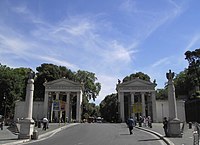
Back Luigi Canina German Luigi Canina Spanish Luigi Canina French Luigi Canina Hungarian Luigi Canina Italian Ludovicus Canina Latin Luigi Canina NB Luigi Canina Polish Канина, Луиджи Russian Luigi Canina Swedish

Luigi Canina (Casale Monferrato, 1795 – Florence, 1856) was an Italian archaeologist and architect.
Luigi Canina, an Italian architect and archaeologist, was born in Casale Monferrato in 1795 and died in Florence in 1856. He was a pupil of Ferdinando Bonsignore in Turin, and settled in Rome in 1818. Among his works are: some construction at the Villa Borghese (monumental neoclassical propylaea from Piazzale Flaminio); Casino Vagnuzzi outside of Porta del Popolo in Egyptian style; not realized projects for reconstruction of the sanctuary of Oropa (1856). He became professor of architecture at Turin, and his most important works were the excavation of Tusculum in 1829 and of the Appian Way in 1848, the results of which he embodied in a number of works published in a costly form by his patroness, the queen of Sardinia. In 1843, he was elected into the National Academy of Design as an Honorary member.

Canina is also noted for his studies of history and archaeology: Ancient architecture described and represented in documents (1830–44). A column opposite the basilica of Saint Sebastian on the Appian Way close to Rome records Canina's work in rescuing many Roman ruins and turning the road into the archaeological park that it is today.
In England, he restored interiors at Alnwick Castle, Northumberland.